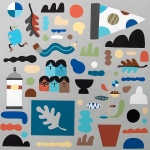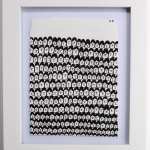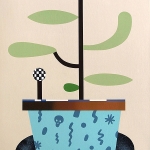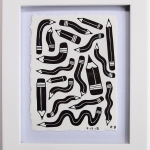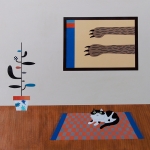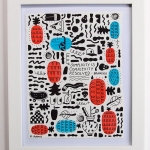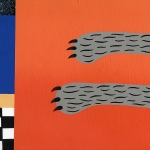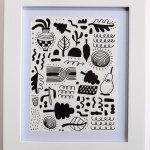Ryan Bubnis will work with just about any material he can get his creative hands on. Whether it is a leftover scrap of sand paper, wood, or vinyl, or an object found on the side of the road. It is this inherently DIY and don’t-waste-a-thing artistic candor that allows Bubnis to manipulate these varied objects into oddly shaped faces and abstract, pattern driven illustrations, paintings, and designs. Bubnis uses the materials he interacts with in his day-to-day to repurpose in his pieces and bring new life, and a new story, to each material.
In his solo exhibition, Simplexity, currently on display at One Grand Gallery in Portland, OR, Bubnis shows off his vivid and whimsical approach to simplifying his shape-based artwork. Bubnis portrays bent pencils, apples, pineapples, and seemingly simple variations of obscure plants in a way that allows each piece to have magic and mystery to them; images that invite the viewer to discover new things every time they look at them. Bubnis, who is constantly drawing, doodling and testing out different variations of faces, shapes, patterns, squiggly lines, and leaves, just stumbles upon his next subject matter, working with a highly intuitive creative process; freely running with the ideas he gets down in his notebook.
The illustrator, educator and artist etched some time out of his busy schedule to talk to Amadeus about the impact of being an artistic educator has had on his own art, coining the phrase “urban folk” and what he finds himself constantly doodling.
Your work has been described as “urban folk.” What does this label mean to you?
A friend of mine once described my work as, “urban folk” and I liked the sound of it. It refers to things that have inspired and influenced my work. Skateboarding, graffiti, folk and outsider art. I’ve always been drawn to folk art and other forms of DIY culture. It’s work that isn’t trying to be overly intellectual. It feels authentic and accessible. It’s people creating things because they love making things with their hands. That really resonates with me. I think the urban side comes from living in cities, skateboarding, and doing graffiti.
You work with a range of materials, ranging from graphite to canvas. Is there any particular medium you prefer working with the most, or find yourself returning to more consistently?
Acrylic paint, latex paint, spray paint, graphite, ink, papier-mâché, etc.
Drawing and painting have always been my starting point. I’ve been working more on canvas these days as my paintings have gotten a little bigger. I really enjoy the challenge of working with new mediums. My wife has been taking ceramics classes at the college I teach at and I’ve slowly begun incorporating my own ceramic pieces into my exhibitions.
How has the convergence of working as an artistic educator at a University and being an artist, translated in your work? Do you find yourself being inspired by your students?
Working as an arts educator has had a huge impact on my current work. I feel more like a student now than I ever did when I was one. I’m constantly researching and looking for new ideas and new content to share with my class and that has definitely informed my practice. It’s extremely rewarding to work with young, emerging artists that are hungry, talented and hard working. I’ve seen some amazing work come out of the illustration program the last few years and I’m proud to be a part of it.
After looking through your catalog of work over the past five years, it looks like you’ve taken a more abstract approach in years past. Although your work is still abstract, it also seems more refined. How have you seen your work grow in the last few years?
I shift back and forth between making representational work and making abstract work. It’s not something that I specifically set out to do. It’s more about listening to my subconscious. Some days I get in the studio and I just start making marks and putting down paint layers. Other days, I know exactly what I’m setting out to make and I’ll create a number of drawings and plans before any paint is applied to a surface. It’s a very organic process.
I like to think that my work has grown both aesthetically and conceptually. It’s been a slow progression but I think the work has become more refined from just making a lot of it. I learn something new from each piece and try to pass that knowledge onto the next one.
Give us a verbal tour of your workspace. Is there music playing? What’s on your desk? Is it cluttered and messy? Clean and organized? Colorful?
I have a small garage studio at my home. It’s cozy but I like the accessibility of it. I have music or a podcast going at all times. I’ve got the usual computer, scanner on one side of the room and an easel and light table set up and stacked with current projects and pieces on the other. If I’m in the middle of working on a project my studio is a complete mess. It’s clean and pristine right before I tackle something new. I usually have finished and in progress paintings hanging on the walls.
What do you find yourself constantly doodling? Any specific shapes or faces?
Faces, skulls, pineapples, pencils, apples, skateboards, squiggles, more faces, blobs and shapes, various mark making, type, etc. I do a lot of drawing in the morning as a warm up to painting and in the evening to wind down.
Talk to us about your solo exhibition in Portland. How long you have been working on this body of work, and what are some of the themes that shine through in these pieces?
I’ve been working on the show on and off for about a year. It consists of paintings, drawings and a few ceramic pieces. It’s titled, Simplexity and is currently on view at One Grand Gallery here in Portland, Oregon. The show for me is a comment on art making. It gets back to that idea of refinement. A friend of mine recently brought this quote to my attention, “Perfection is achieved, not when there is nothing more to add, but when there is nothing left to take away.” It’s by Antoine de Saint-Exupéry, the author of the Little Prince.
I’ve found that it’s extremely challenging to make something simple, concise and meaningful. The end result may appear simplistic but there are countless hours of editing, failure and problem solving that got you to that point. I’ve often wondered, “how can an unplanned, intuitive drawing contain as much or more vitality than a large-scale painting that took months to plan and execute?”
Does your style differ from commissioned work vs.your exhibitions and personal portfolio?
There is a lot of cross over between the two disciplines and they really feed off each other. The work I create for exhibitions is all done with traditional media and a lot of my commercial work starts out analog and then gets compiled digitally. With client work you are collaborating on a prompt or concept that is given to you. The exhibitions are all about your personal vision. I like to think it’s the same voice placed in different contexts.
For more from Ryan Bubnis follow him on Instagram, or check out his latest body of work at One Grand Gallery.


